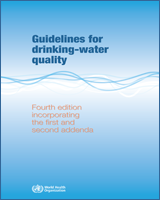Annanmäki
M, ed. (2000) Treatment techniques for removing natural radionuclides from drinking water. Final report of the TENAWA Project. Helsinki, Radiation and Nuclear Safety Authority (STUK-A169).
APHA, AWWA, WEF (2005) Standard methods for the examination of water and wastewater, 21st ed. Washington, DC, American Public Health Association, American Water Works Association and Water Environment Federation, pp. 7–15.
ASTM (1998) ASTM annual book of standards. Vol. 11.02. Philadelphia, PA, American Society for Testing and Materials.
Bring
R, Miller
AG (1992) Direct detection of trace levels of uranium by laser induced kinetic phosphor¬imetry. Analytical Chemistry, 64:1413–1418.
Chiu
NW, Dean
JR (1986) Radioanalytical methods manual. Ottawa, Ontario, Canadian Government Publishing Centre, Canadian Centre for Mineral and Energy Technology, National Uranium Tailings Program (CANMET Report 78-22).
Crawford-Brown
DJ (1989) The biokinetics and dosimetry of radon-222 in the human body following ingestion of groundwater.
Environmental Geochemistry and Health, 11:10–17. [
PubMed: 24202200]
Department of National Health and Welfare (1977) Chemical procedures for the determination of 89Sr, 90Sr, and 137Cs in surface waters, fresh-water algae and fresh-water fish. Ottawa, Ontario, Department of National Health and Welfare (Report 77-EHD-14).
Health Canada (2000) Environmental radioactivity in Canada 1989–1996. Available from Environmental Radiation Hazards Division, Radiation Protection Bureau, Health Canada, Ottawa, Ontario [see also earlier editions of Environmental radioactivity in Canada].
Health Canada (2004) Point-of-use and point-of-entry treatment technologies for the removal of lead-210 and uranium from drinking water. Richmond Hill, Ontario, Senes Consultants Ltd.
Igarashi
Y, Kawamura
H, Shiraishi
K (1989) Determination of thorium and uranium in biological samples by inductively coupled plasma mass spectrometry using internal standardization. Journal of Analytical Atomic Spectrometry, 4:571–576.
ISO (2003) Standard ISO 5667 3: Water quality—Sampling—Part 3: Guidance on the preservation and handling of water samples. Geneva, International Organization for Standardization.
ISO (2006) Standard ISO 5667 1: Water quality—Sampling—Part 1: Guidance on the design of sampling programmes and sampling techniques. Geneva, International Organization for Standardization.
ISO (2006) Standard ISO 5667-5: Water quality—Sampling—Part 5: Guidance on sampling of drinking water from treatment works and piped distribution systems. Geneva, International Organization for Standardization.
ISO (2007) Standard ISO 9696: Water quality—Measurement of gross alpha activity in non-saline water—Thick source method. Geneva, International Organization for Standardization.
ISO (2007) Standard ISO 10703: Water quality—Determination of the activity concentration of radionuclides—Method by high resolution gamma-ray spectrometry. Geneva, International Organization for Standardization.
ISO (2008) Standard ISO 9697: Water quality—Measurement of gross beta activity in non-saline water—Thick source method. Geneva, International Organization for Standardization.
ISO (2009) Standard ISO 5667-11: Water quality—Sampling—Part 11: Guidance on sampling of groundwaters. Geneva, International Organization for Standardization.
ISO (2009) Standard ISO 10704: Water quality—Measurement of gross alpha and gross beta activity in non-saline water—Thin source deposit method. Geneva, International Organization for Standardization.
ISO (2010) ISO 969: Water quality—Determination of tritium activity concentration—Liquid scintillation counting method. Geneva, International Organization for Standardization.
ISO (2010) Standard ISO 11704: Water quality—Measurement of gross alpha and beta activity concentration in non-saline water—Liquid scintillation counting method. Geneva, International Organization for Standardization.
ISO (in preparation) Standard ISO 13160: Water quality—Measurement of strontium 90 and strontium 89. Geneva, International Organization for Standardization.
ISO (in preparation) Standard ISO 13161: Water quality—Measurement of polonium 210 activity concentration in water by alpha spectrometry. Geneva, International Organization for Standardization.
ISO (in preparation) Standard ISO 13162: Water quality—Determination of carbon 14 activity—Liquid scintillation counting method. Geneva, International Organization for Standardization.
ISO (in preparation) Standard ISO 13163-1: Water quality—Measurement of lead 210 activity concentration—Part 1: Liquid scintillation counting method. Geneva, International Organization for Standardization.
ISO (in preparation) Standard ISO 13164-1: Water quality—Measurement of the activity concentration of radon-222 and its short-lived decay products—Part 1: Radon origins and measurement methods. Geneva, International Organization for Standardization.
ISO (in preparation) Standard ISO 13164-2: Water quality—Measurement of the activity concentration of radon-222 and its short-lived decay products—Part 2: Direct measurement by gamma spectrometry. Geneva, International Organization for Standardization.
ISO (in preparation) Standard ISO 13164-3: Water quality—Measurement of the activity concentration of radon-222 and its short-lived decay products—Part 3: Indirect measurement with degassing. Geneva, International Organization for Standardization.
ISO (in preparation) Standard ISO 13165-1: Water quality—Measurement of radium 226 activity concentration—Part 1: Liquid scintillation counting method. Geneva, International Organization for Standardization.
Lariviere
D
et al. (2009) Rapid and automated analytical technologies for radiological nuclear emergency preparedness. In: Koskinen
AN, ed. Nuclear chemistry: New research. Nova Science Publishers, Inc., pp. 99–154.
Prichard
HM, Gesell
TF (1977) Rapid measurements of
222Rn concentrations in water with a commercial liquid scintillations counter.
Health Physics, 33:577–581. [
PubMed: 604301]
Prichard
HM, Venso
EA, Dodson
CL (1991) Liquid scintillation analysis of 222Rn in water by alpha/beta discrimination. Radioactivity and Radiochemistry, 3:28–26.
USEPA (1980) Prescribed procedures for measurement of radioactivity in drinking water. Washington, DC, United States Environmental Protection Agency (EPA 600/4-80-032).
USEPA (1987) Two test procedures for radon in drinking water. Appendix D. Analytical test procedure. Washington, DC, United States Environmental Protection Agency, p. 22 (EPA/600/2-87/082).
USEPA (1999) National primary drinking water regulations; radon-222. Washington, DC, United States Environmental Protection Agency. Federal Register, 64(211).
USEPA (2000) National primary drinking water regulations; radionuclides; final rule. Washington, DC, United States Environmental Protection Agency (40 Code of Federal Regulations Parts 9, 141 and 142).
USEPA (2000) Radionuclides notice of data availability technical support document. Prepared by Office of Groundwater and Drinking Water, United States Environmental Protection Agency, in collaboration with Office of Indoor Air and Radiation, USEPA, and United States Geological Survey.
Vitz
E (1991) Toward a standard method for determining waterborne radon.
Health Physics, 60:817–829. [
PubMed: 2032836]
Volchok
HL, de Planque
G, eds (1983) EML procedures manual, 26th ed. New York, NY, United States Department of Energy, Environmental Measurements Laboratory (HASL-300).
WHO (2002) Establishing a dialogue on risks from electromagnetic fields. Geneva, World Health Organization.
WHO (2009)
WHO handbook on indoor radon: A public health perspective. Geneva, World Health Organization. [
PubMed: 23762967]

